The Microsoft Lumia 640 Review
by Brandon Chester on June 9, 2015 8:00 AM EST- Posted in
- Smartphones
- Microsoft
- Mobile
- Lumia
- windows phone 8
Display
Smartphone displays have rapidly improved at every single price point. Inexpensive smartphones often compromised on display quality, which ended up hurting much of the overall experience. However, even inexpensive smartphones now ship with IPS displays and high enough resolutions to render text without overwhelming aliasing.
The Lumia 640 has a 5" 1280x720 IPS display. At 294 pixels per inch, it’s fairly sharp for a phone of this price. It’s obviously not some 2560x1440 flagship phone, but I never felt like text appeared fuzzy or highly aliased. To evaluated the aspects of display quality beyond what you’ll see on a spec sheet we turn to our standard smartphone display tests. As always, measurements are performed with X-Rite's i1Pro 2 spectrophotometer and SpectraCal's CalMAN 5 software, with the exception of contrast measurements which are done with an i1Display Pro colorimeter.
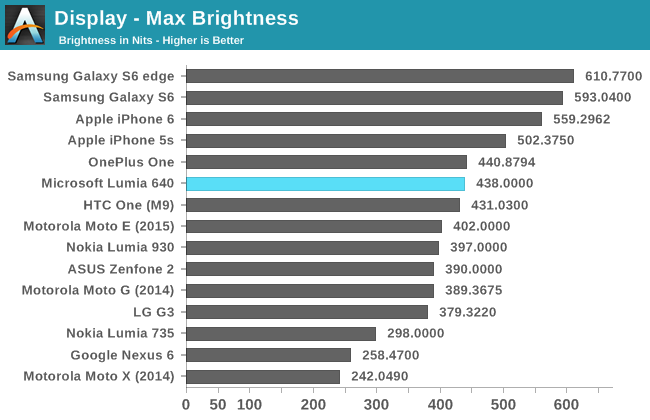
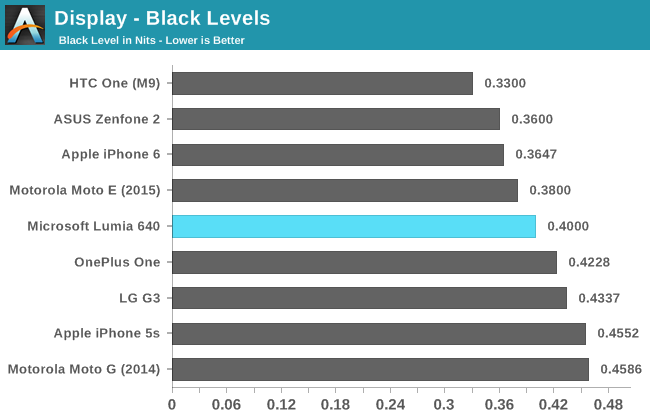
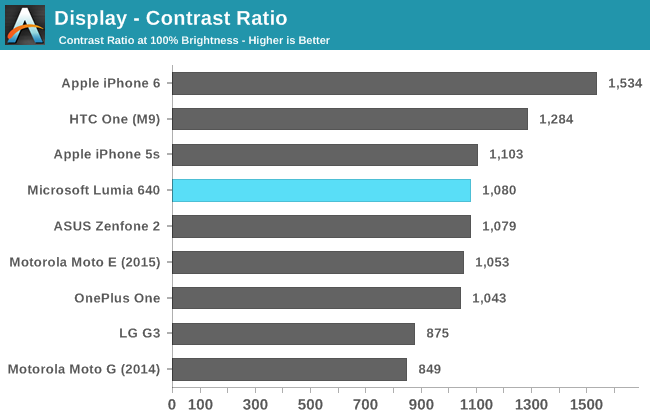
437 nits is a fairly good result for peak brightness. It’s not quite as high as the 500 and 600nit displays that you’ll see on flagship phones, but it’s noticeably higher than many other devices at this price point. The contrast is also pretty good. While the black level isn’t even close to the lowest we’ve seen, when you consider that many devices use CABC to cheat on contrast it’s actually a relatively good result.
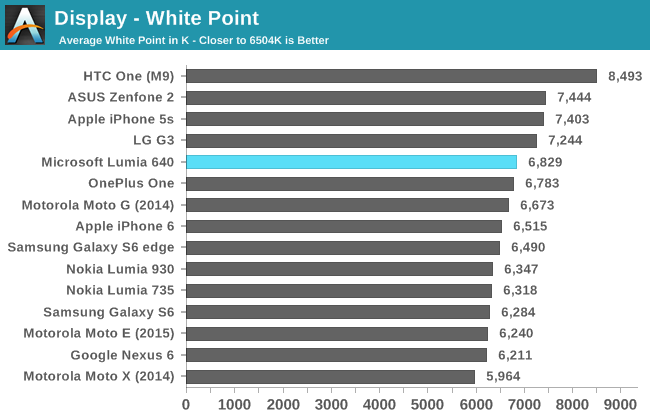
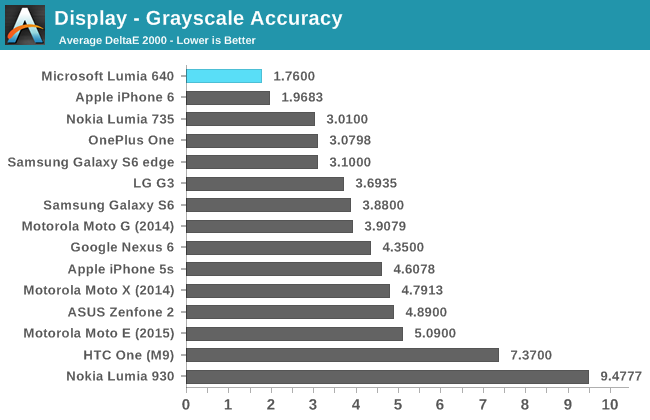
The greyscale results on the Lumia 640 are exceptional. RGB balance is great at every shade of grey, with only a very slight shift toward blue. All of the errors will only be visible if you compare static images with a reference monitor. There’s not much more to be said, as the greyscale accuracy on this display is essentially perfect.
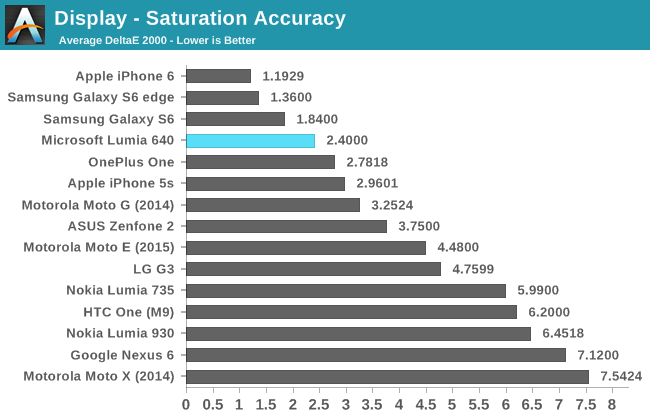
The next test examines saturations of primary and secondary colors on the display in increments of 20%. In this test the Lumia 640 does very well. There are definitely some issues with blue and magenta, and the fact that cyan maxes out at 80% saturation, but the overall accuracy is very good.
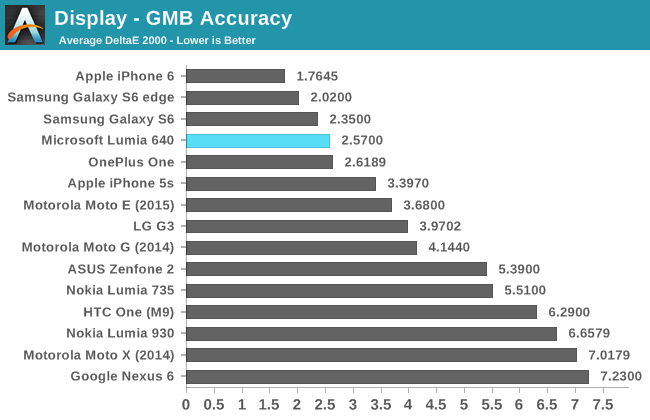
The final display benchmark is the Gretag MacBeth ColorChecker test. This test examines colors that are commonly found in the real world, and it’s the best benchmark of display color rendition. A display can hit its saturation targets accurately but fail to reproduce these color mixtures properly.
Fortunately, the Lumia 640 suffers from no such issues. Most of the colors are reproduced with a high degree of accuracy, with the big errors being in shades of blue. Skin tones are very well reproduced, which is something I’ve seen other devices struggling with in recent reviews.
Overall, the Lumia 640’s display is very good, and I would go as far as to say that it’s one of the best displays on a phone at this price point. It performs well in every category, from brightness, to contrast, to color accuracy, and the resolution is high enough to keep everything looking fairly sharp. I think Lumia 640 users will be very happy with the display on their phone.


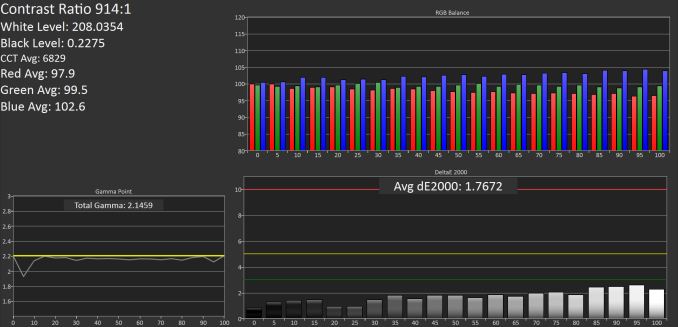











130 Comments
View All Comments
Wolfpup - Tuesday, June 9, 2015 - link
Out of curiosity, what's slow about the 521? It's main limitation is RAM I think, but then that mostly just means it has to load a bit more when switching programs.Of the mobile OSes right now I like iOS best (though obviously I like real Windows far, far better), but I pad $950 for my iPhone and when it broke replaced it with a Lumia 635, and...honestly it's nearly as good, for my use at least. The podcast program actually syncs with iTunes too, and there's nothing on Android that does that for real. (I've seen things CLAIM to, but they don't actually.)
mockyboy - Tuesday, June 9, 2015 - link
Once I upgraded to Windows Phone 8.1, it became noticeably slower. Apps crashing, phone freezing, getting the resuming message for 20 seconds or so. And I don't have that much loaded on it.testbug00 - Tuesday, June 9, 2015 - link
oh, in that case, a 640 should be fine. The issue you're running into is most likely RAM.testbug00 - Tuesday, June 9, 2015 - link
Unless you're set on Windows Phone, going with a Moto X 2013 (http://www.amazon.com/Motorola-Moto-XT1058-16GB-Un... is probably the best option.Or, if you want/need SD card, get the newest Moto G. Make sure one of the ones with SD card slot, if Moto is still segmenting that.
From WindowsPhoneLand, there isn't anything that technically has a faster SoC that isn't $300+ iirc. At least, not now.
If you don't mind buying used, I would check out swappa.com, everything I've got off there has been great so far. hope it still is.
Harry_Wild - Thursday, June 18, 2015 - link
I have an iPhone 6 and it is super fast and has tons of high quality apps too! I use currently the iPhone 6 and Lumia 735. Both are 4.7". I would recommend the iPhone 6 if you can afford it! But the Lumia 735 is pretty nice at the now low price of $200. I purchase it at $300.jjj - Tuesday, June 9, 2015 - link
It's weird how Metro makes the phones look bulky and crowded, the childish icy iOS rainbows are quite the opposite. Not that M$ should copy that, just the message.They also need to dump this kind of back shell. Nokia, iphone 5c, Xiaomi Redmi and many others turned this kind of shell into the definition of cheap and the way they implement it makes the phones bulkier too.
As for this device ,too bad for the SoC , guess for a startup like Microsoft it's normal to not have the resources to make it's software run on A53.
StormyParis - Tuesday, June 9, 2015 - link
that kind of back shell does make an additional case 'which 75% of smartphone users add) unnecessary. I think the Nokia should be compared to case-equipped iPhone et al, and then the bulk issue goes the other way. I'm not a Nokia customer, but I'd love to have a similar design on my Androids.Callum S - Tuesday, June 9, 2015 - link
Completely agree here. It's always been a massive benefit. They're normally thinner than even the most expensive phones with a case, that makes them feel cheap and fat anyway, or much better value and safer than using an alternative phone without one.Additionally, as someone who has very rarely used phone cases, I have always found phones with easily replaceable cases beneficial for both appearance when I have dropped and damage them (no walking around with cracked phone cases or backs like so many people with iPhones) and for when I want to pass them down to other family members. After a fresh install and a new $15 back shell it's essentially like a new phone for those who aren't too concerned.
damianrobertjones - Tuesday, June 9, 2015 - link
Not bad at all really especially for people that don't care or ever need something faster.GlobeGadget - Tuesday, June 9, 2015 - link
My first smartphone was Nokia Lumia 800, it was a pretty great phone but it wasn't as great as the 3310 when it met the pavement... :(